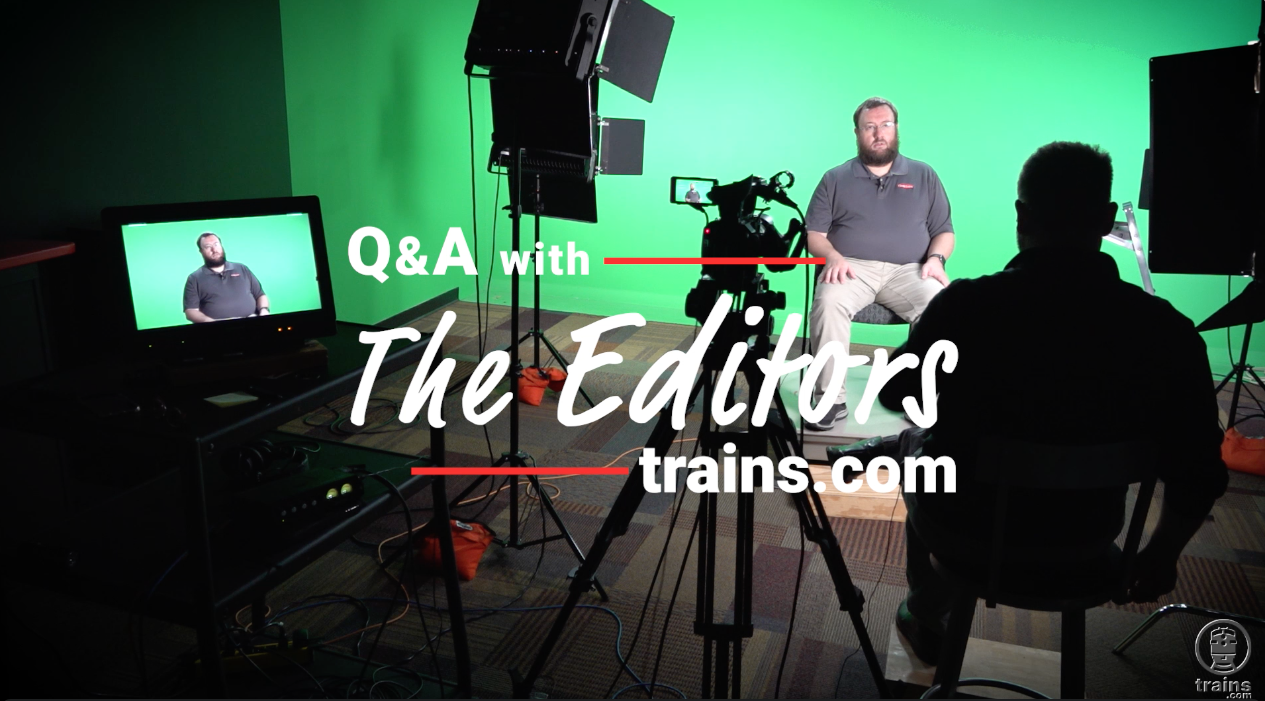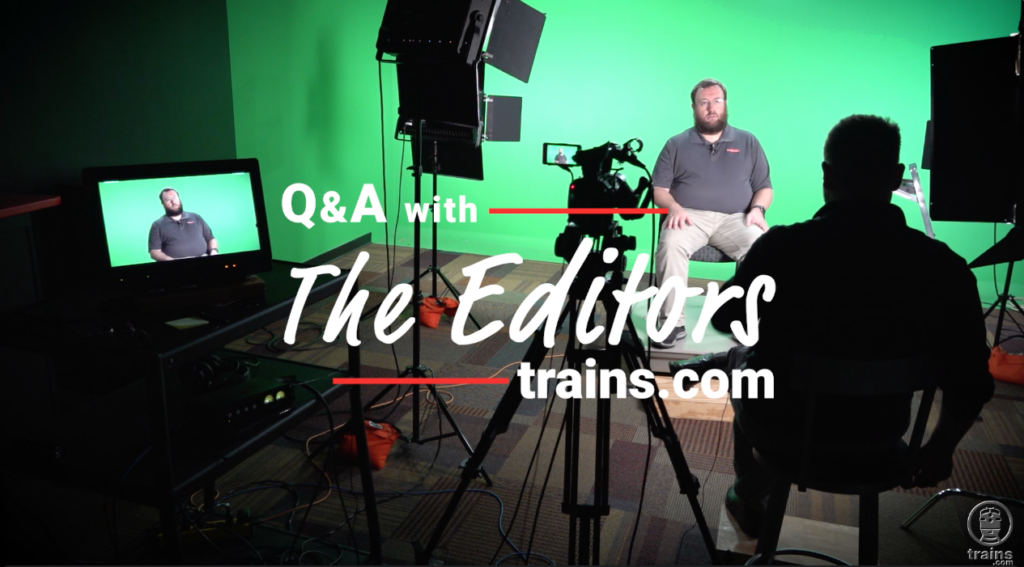Meet Brian Schmidt, Classic Trains Editor in this Q&A with the Editors. Trains.com Unlimited Members can see the video in the Trains.com Video section.

Steve Sweeney: Well, ladies and gentlemen, welcome back to another episode of Q&A with the Editors. We’re so pleased that Brian Schmidt could join us this time. Brian Schmidt is editor of Classic Trains magazine. Brian, welcome.
Brian Schmidt: Thank you for having me.
SS: So, you have been editor at Classic Trains just a little less than a year. Could you tell us a little bit about yourself and how you came to that position?
BS: I worked for Trains Magazine since June of 2012. Jim Wrinn hired me there as the news editor at the time, and I started out doing News Wire and news in print. Over time, I transitioned to do more print product and feature story editing. When David Ingles retired, I think it was 2018, Rob had picked me from the Trains staff to join him part time and split my time between the two magazines and help him edit features and work on web content for Classic Trains.
SS: And then Rob recently retired, and you stepped into the role full time.
BS: Yes. Rob retired in late 2021, and I took over in early November of 2021. So, it’s been, like you said, almost a year now and it’s been it’s been a great ride. I’m almost through a whole cycle of magazines. I started with a spring issue, and I’ve been through spring, summer, and fall. So, three quarters of the year done, at least in publishing.
SS: Fantastic. Brian, one of the features of this Q&A video with the editors is that I do have five stock questions that I’d like to ask you. And the first one is, what is your favorite railroad, present or past, and why?
BS: Well, this is funny. I’m from Ohio, but my favorite railroad has always been the Milwaukee Road. And the Milwaukee had everything: It had a narrow gauge, it had branch lines, it had a main line to the West Coast, it had the high-end passenger trains, and it had the appeal of the grain-gathering branches. So, it was a multifaceted railroad. It went to a lot of different places, and it seemed overlooked. At least around where I was at, compared to the people who were fans of the New York Central or the Santa Fe. Everybody was a fan of the Central or Santa Fe, but the Milwaukee seemed like the true underdog. And the more I’ve learned about it, the more I’ve come to realize that was true.
But being from Ohio, I’m also a fan of Ohio railroads, and I’m out of Milwaukee. Is that one of your questions? But I’m a fan of the Detroit, Toledo and Ironton, and the Wabash because they were both in my hometown in Ohio.
SS: What is the best part about what you do?
BS: The best part of what I do is bringing new people into the hobby and helping people find their joy with railroads and trains. And I think with Trains.com, we reach a whole bunch of new people than the magazine ever has. But, making sure that there are stories in there that people can relate to and find what they really like in railroading.
SS: Brian, tell us about something exciting you’ve been working on lately.
BS: I think one of the most exciting things I worked on lately has been the Centennial Anniversary issue. It was our summer issue for EMD (Electro-Motive Division of General Motors), the preeminent diesel locomotive builder for most of the classic era, and 2022 has been the centennial. It was fun because Rob had, sort of, half of the issue lined up when he left. But it was the first issue where I got to really come in and pick some stories. It’s just fun to see something so transformative as EMD has been and how we celebrate that today.
You look back, especially to the steam-diesel transition period, there were a lot of rail fans who put their cameras away when steam went away. Especially good color photos of diesels as delivered can be hard to find or the ones that are out there have been published ad nauseum. But, to look back now at the legacy of EMD as people at one time thought, “Diesels were the end of interest in railroading.” That is clearly not been the case. But we see what that legacy is and what transformed it in the industry, and it’s just fun to have that perspective being with Classic Trains.
SS: What interests you most about the hobbies that are associated with what we do: Railfanning, modeling, research, and archeology?
BS: That’s a loaded question. What interests me the most about railroading? It’s funny because there are so many different facets to the railroad hobby you can do. You can be a diesel person and count, just like the British style, how many railroads and locomotives have I seen. You can get really down into the photography or videography. Or you can be a modeler.
I think I touch on this is, I’m an N-scale modeler of the Milwaukee Road. When I was more active as a rail fan in the last 20 years, I was really into operations and how cars moved, how crew districts worked, routing of freight, and things like that. I’m learning more about that in the classic era, especially because there’s so many documents. You can find blocking diagrams and traffic charts from a lot of old railroads. There’s just so many different aspects.
I’ve always been into photography. I think my interest in trains spawned a separate interest in photography. I photographed a lot of other things that I might not have if I hadn’t had that original interest in photographing the trains that I saw.
SS: Fascinating. Okay, I’m really expecting a lot out of you on this one. If you were working for the railroad, what railroad craft or position best describes you?
BS: Well, who’s the guy that complains and swears the most? I don’t know. I would say, realistically being an editor, it’s the train master. The train master in the classic era was involved with crews, crew scheduling, who had days off, and just being the frontline manager. But that position also dealt a lot with customers, making sure customers were being fed the empty cars that they needed, and making sure they were getting switched in a timely manner.
All that kind of feels like being an editor that I have to deal with. Internally, instead of people, I deal with stories and deadlines. Externally, I still deal with customers and if someone’s issue is late, I hear about it. If I did a good job, I hear about that too. So that’s good and that’s a lot like what a classic-era train master would have been.
SS: So, you’ve talked a little bit about modeling, but it’s an interesting crossover. Being the editor of a railroad history magazine and being a model, how much do you think one side of your life informs the other?
BS: Probably too much. As we recall, model railroading is fun, from years ago, and I try to keep that mentality. I model a specific railroad at a specific time, the Milwaukee Road branch to Fond du Lac, Wis., in the 1960s. But I do it for fun, I’m an operations guy. So, for me, building the model railroad is the means to the end of getting to operate it and have my friends over and run trains. I feel that sometimes I let the history get in the way of that end goal. I look for photos of buildings to scratch build, or what specific types of boxcars that I’m operating like, “Did it have this series or that series on the branch line, and what evidence do we have?”
For me, it’s borderline too much information, and I’m trying to get back to just having fun building model trains. I’ve been a subscriber to Model Railroader for more than 30 years, which predates really my interest in real trains. Being a rail fan was an outgrowth of being a model railroader. So, I have to remember sometimes that model railroading is my original interest and I need to keep that. As the magazine cover said, “model railroading is fun.”
SS: So, it’s sort of a strange question to ask, what is the future of a history magazine? What do you see in store for Classic Trains in the next 10 years?
BS: I can answer pretty safely, the next 10 years, the history is going to be the 1990s. The magazine started in 2000, and at the time, the cut off was 30 years ago. And 20 years from then, I’ve moved that cut off 20 years. So, 10 years from now, we’ll be looking back at the 1990s with the same fondness that the original Classic Trains looked back to the 1960s with, because they’ll be the same distance in the rearview mirror.
I think that’ll be great for bringing the next generation in. Every magazine editor everywhere wonders where the next generation of readers are going to come from, and I feel pretty confident that they’re going to come looking for the end of the Santa Fe, the end of Conrail, and the end of the Southern Pacific because those are now already 20-25 years ago.
SS: So true. Brian, thank you so much for joining us today. I wanted to take this opportunity to ask you if there’s anything else that you would like to add to our conversation, or anything you’d like to go over that we hadn’t had an opportunity to talk about.
BS: I just want to say that I’m thrilled to have the opportunity to run Classic Trains. I worked 10 years at Trains, but working on the historic side of it was always my favorite and I’m looking forward to bringing a new generation of railroad history to a new generation of railroad historians.
SS: Brian, thank you.
BS: Thank you for having me.

